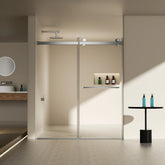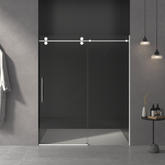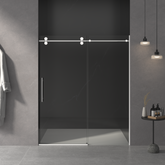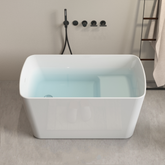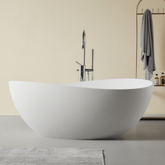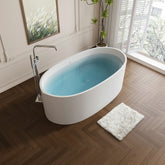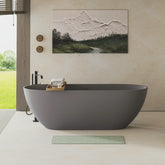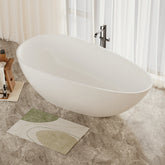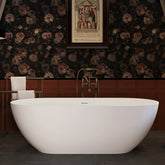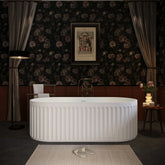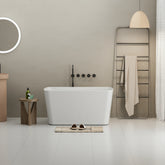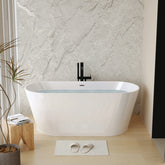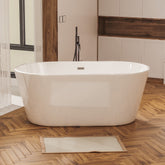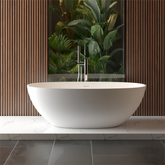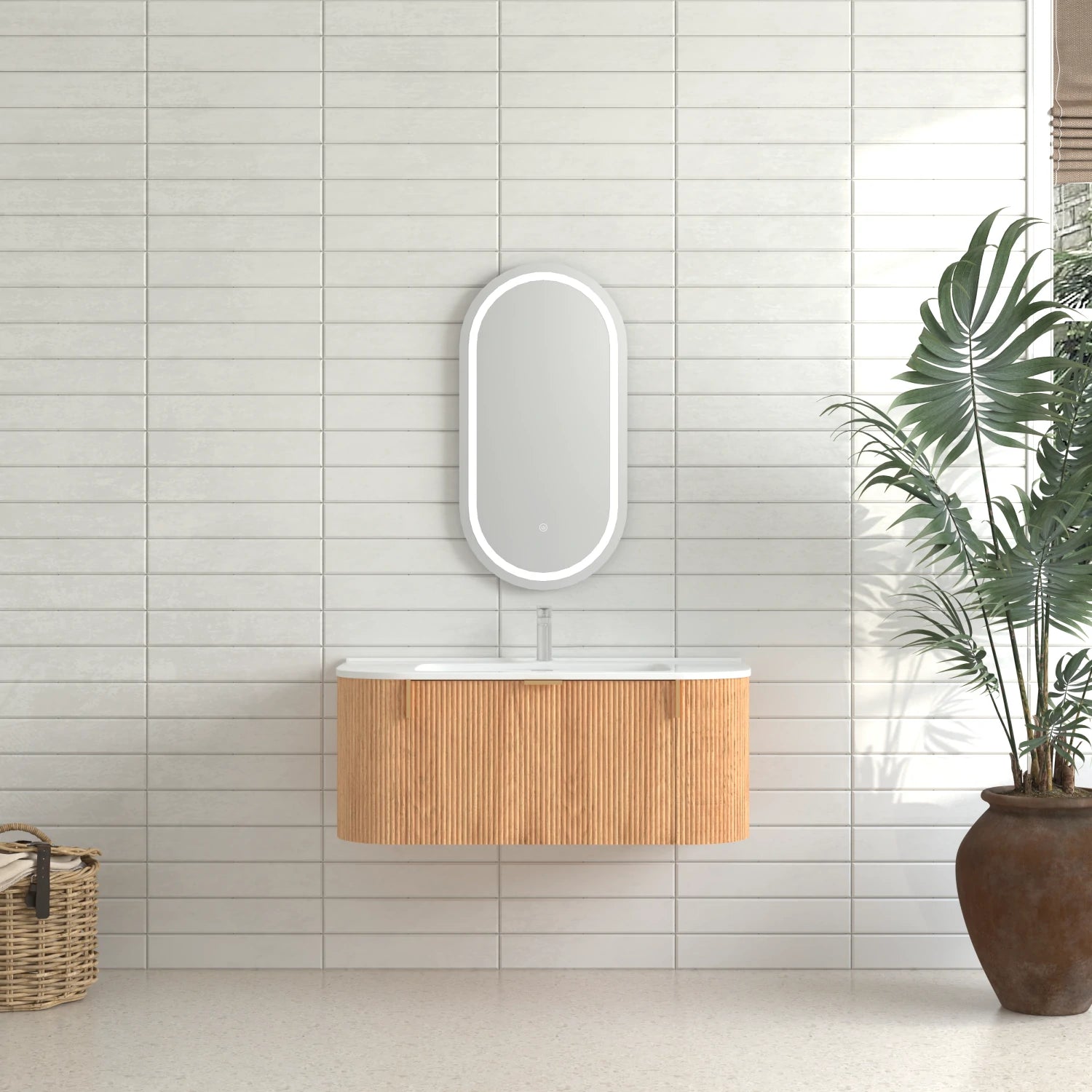Tips for Choosing the Perfect Bathtub for Small Bathrooms
1. Introduction
As modern living spaces become increasingly compact, small bathrooms have turned into both a design challenge and an opportunity for creativity. I’ve seen many homeowners struggle to balance functionality, comfort, and style in limited square footage — especially when it comes to choosing the right bathtub. A bathtub for small bathrooms isn’t just about finding something that fits; it’s about selecting a design that enhances the overall experience of the space.
From my perspective, the perfect small bathroom bathtub should combine smart space utilization with aesthetic appeal. Whether it’s a compact freestanding tub that makes a statement or a corner bathtub that cleverly saves floor area, the right choice can completely transform the atmosphere of your bathroom. Even a small soaking tub can bring a sense of relaxation and luxury without overwhelming the layout.
In this article, I’ll share my best tips for choosing the perfect bathtub for small bathrooms. We’ll explore how to measure your space effectively, the different bathtub types suited for compact areas, and which materials and designs can make your bathroom feel larger and more inviting. By the end, you’ll have a clear understanding of how to achieve both style and practicality, even in the smallest of bathrooms.

2. Assess Your Bathroom Space
Before falling in love with a particular bathtub for small bathrooms, I always start by carefully assessing the space I’m working with. It might sound simple, but precise measurements are the foundation of a successful bathroom design. I measure the length, width, and height of the room, making sure to note any architectural details—like alcoves, corners, or window placements—that could influence the bathtub’s position.
Plumbing layout is another critical factor. I’ve learned that relocating drains or water lines can dramatically affect both the cost and the complexity of installation. So instead of forcing a design that doesn’t fit, I try to work with the existing plumbing whenever possible. Door clearance and traffic flow are also key considerations—there’s nothing worse than a door that bumps into your tub every time it opens.
In small bathrooms, even a few inches can make or break the design. Choosing a compact bathtub or a small soaking tub that aligns perfectly with your available space ensures comfort without compromise. The goal is to create a sense of openness, where every inch contributes to both practicality and beauty. By fully understanding the space first, I can make smarter, more confident decisions when selecting the perfect bathtub.

3. Choose the Right Bathtub Type
When working with limited space, I’ve realized that choosing the right bathtub type can completely change how a small bathroom looks and feels. Each design serves a unique purpose — it’s not just about fitting the tub into the room, but about how it complements your layout, enhances comfort, and maintains visual balance. Here’s how I evaluate the most popular small bathroom bathtub ideas and decide which one works best.
Alcove Bathtub
The alcove bathtub is one of my top choices for narrow or rectangular bathrooms. Installed between three walls, it maximizes space efficiency while maintaining a clean, integrated look. It’s ideal for those who want a space-saving bathtub that also doubles as a shower area. I find this type especially practical for family bathrooms or apartments where every inch counts.
Corner Bathtub
If your bathroom layout feels awkward or underutilized, a corner bathtub can be a smart solution. I love how it transforms unused corners into functional relaxation zones. The diagonal positioning not only saves valuable floor space but also adds a soft, organic flow to the overall design. It’s perfect for those who want a comfortable soak without dominating the center of the room.
Freestanding Compact Tub
For homeowners who crave a touch of elegance, a freestanding compact bathtub is an excellent choice. Despite its smaller size, it exudes a luxurious, spa-like vibe and works beautifully in open layouts. Personally, I find that pairing a freestanding tub with minimalist fixtures or an LED mirror instantly elevates the ambiance. Just remember to leave enough clearance around it for easy cleaning and access.
Walk-in Bathtub
Accessibility shouldn’t be overlooked, especially in multi-generational homes. A walk-in bathtub offers safety and convenience without sacrificing design appeal. It’s particularly suitable for compact bathrooms where step-in tubs or high ledges might be impractical. From my experience, these tubs blend function with comfort — an excellent investment for both safety and long-term usability.
Ultimately, the best bathtub for small spaces depends on how you want your bathroom to serve you — whether it’s a place for quick refreshment, deep relaxation, or daily practicality. The right choice will balance space efficiency with the comfort and aesthetic that match your lifestyle.

4. Prioritize Space-Saving Features
When designing for a compact bathroom, I’ve learned that every design detail matters. The key to creating a comfortable and stylish space lies in choosing a bathtub for small bathrooms that offers both form and function. To me, the smartest designs are those that make the most of limited square footage — integrating thoughtful space-saving features without sacrificing comfort or aesthetics.
Built-in Shelving or Ledges for Storage
One of my favorite tricks is selecting a compact bathtub with built-in shelves or side ledges. These subtle additions make a big difference in small bathrooms, providing just enough space for essentials like soap, candles, or towels without the need for extra storage furniture. I find that built-in ledges also create a cleaner, more organized look — an important factor in maintaining the illusion of space.
Curved or Asymmetrical Designs
Traditional rectangular tubs don’t always make the best use of limited space. I often recommend curved or asymmetrical bathtubs because their shapes naturally adapt to awkward layouts or tight corners. A corner curve can open up valuable floor area, allowing for smoother movement around the room. These designs not only optimize space but also add a touch of modern elegance that makes small bathrooms feel intentionally designed rather than constrained.
Deep Soaking Tubs with Shorter Lengths
For homeowners who want a relaxing soak but lack the room for a standard tub, a deep soaking tub is the perfect solution. I personally love how these tubs offer luxurious comfort in a smaller footprint. Their shorter length saves space, while their extra depth allows for full immersion — ideal for relaxation after a long day. It’s a beautiful reminder that comfort isn’t defined by size but by thoughtful design.
In my experience, combining these small bathtub ideas — from smart storage to ergonomic shapes — can make even the tiniest bathroom feel functional, open, and inviting. It’s all about finding clever ways to make space work harder without compromising your personal style.

5. Pick the Right Material
When choosing a bathtub for small bathrooms, size and style are important — but material choice is equally critical. Over the years, I’ve learned that the right material not only affects how your bathtub looks and feels but also impacts installation, maintenance, and overall longevity. For compact spaces, it’s essential to balance durability, weight, and visual harmony with the rest of the bathroom design.
Acrylic: Lightweight and Affordable
Whenever I’m working on a small bathroom renovation, acrylic bathtubs are often my go-to recommendation. They’re lightweight, making them easier to transport and install — an important factor when dealing with tight spaces or upper floors. Acrylic also retains heat well and comes in a variety of shapes and finishes, which makes it ideal for small soaking tubs or space-saving bathtub designs. Plus, if scratches occur, they can usually be buffed out easily, keeping the surface looking new for years.
Fiberglass: Budget-Friendly and Practical
If cost efficiency is a top priority, a fiberglass bathtub is worth considering. I often recommend this option for quick renovations or rental properties, as it offers good value for its price. Fiberglass is lightweight and easy to install, though it may not last as long as other materials. For a temporary solution or secondary bathroom, it’s a practical, no-fuss choice that still supports a modern aesthetic.
Cast Iron: Durable but Heavy
When it comes to longevity and timeless appeal, cast iron bathtubs are unmatched. I love their solid feel and excellent heat retention — perfect for long, relaxing soaks. However, in a small bathroom, weight can be a concern. Before installation, I always make sure the floor structure can handle the load. While it’s not the easiest option for compact spaces, a well-placed cast iron tub can add unmatched luxury and durability to your design.
Stone Resin: Modern Minimalism at Its Best
For clients seeking a balance between elegance and practicality, stone resin bathtubs are a personal favorite. They’re sleek, durable, and offer a matte finish that complements modern small bathroom designs. Despite being slightly heavier than acrylic, stone resin provides excellent insulation and a high-end aesthetic, making it ideal for luxury small bathrooms or minimalist interiors. It’s the perfect material for homeowners who want to achieve a premium look without overwhelming the space.
In my experience, selecting the right bathtub material is about more than just appearance — it’s about matching the product to your lifestyle, budget, and space limitations. Whether you value affordability, strength, or luxury, the right choice will ensure that your small bathroom bathtub remains both functional and beautiful for years to come.

6. Consider Design Aesthetics
While functionality is essential, I’ve found that aesthetics play an equally powerful role in making a small bathroom feel more spacious and inviting. The right bathtub for small bathrooms should not only fit physically but also visually harmonize with the entire room. In compact spaces, design choices—color, shape, and materials—can dramatically influence how open and luxurious the bathroom feels.
Neutral Colors for a Larger Appearance
Whenever I design small bathrooms, I lean toward neutral color palettes such as white, beige, or light gray. These tones reflect light better and create a sense of depth, making the room appear larger than it actually is. A white small soaking tub paired with light tiles can instantly brighten the space. I sometimes add subtle contrasts through natural textures—like wood accents or matte black fixtures—to keep the design from feeling flat while maintaining that airy, open look.
Slim Edges and Clean Lines
In small bathroom designs, simplicity is sophistication. I always prefer compact bathtubs with slim edges and smooth, clean lines. They visually reduce bulk and make the layout feel less cluttered. A space-saving bathtub with a minimalist silhouette naturally complements modern interiors and enhances the perception of space. To me, these refined details turn a tight layout into a calming, intentional design statement.
Combine with LED Mirrors and Glass Shower Doors
Lighting and reflections can transform the atmosphere of a small bathroom. I often pair a sleek bathtub design with LED mirrors and glass shower doors to maximize brightness and openness. The transparent surfaces eliminate visual barriers, while LED lighting adds a warm, spa-like glow. This combination not only makes the bathroom feel more spacious but also elevates its sense of modern luxury.
Ultimately, good design isn’t about how much space you have—it’s about how you use it. By focusing on color harmony, simple geometry, and reflective materials, I’ve seen even the smallest bathrooms turn into serene, elegant sanctuaries. The right aesthetic choices ensure your small bathroom bathtub feels not just practical, but beautifully integrated into your daily life.

7. Plan for Easy Installation and Maintenance
When selecting a bathtub for small bathrooms, I always remind myself that beauty and comfort mean little if the installation or upkeep becomes a constant headache. In compact spaces, every detail — from how the tub is delivered to how it’s maintained — can affect your overall experience. That’s why planning for easy installation and maintenance is just as important as choosing the right style or material.
Choose Models That Fit Tight Spaces
Over the years, I’ve learned that not every bathtub is built with small bathrooms in mind. I prefer compact bathtubs that are lightweight and designed for easy maneuvering through narrow hallways or doorways. Alcove and freestanding small bathtubs with simple plumbing connections often make installation quicker and less invasive. It’s always worth confirming the exact measurements — even a few extra inches can create unexpected challenges in tight layouts.
Opt for Maintenance-Friendly Surfaces
In a small bathroom, maintenance becomes part of the design conversation. I look for bathtubs made from materials that are easy to clean, anti-scratch, and resistant to mold or discoloration. Acrylic and stone resin tubs, for example, are not only stylish but also require minimal effort to keep spotless. A smooth, non-porous surface doesn’t just save cleaning time — it keeps your bathroom looking newer for longer, even with daily use.
Consider the Benefits of Professional Installation
While some compact bathtubs are marketed as DIY-friendly, I’ve seen how professional installation can prevent a host of problems down the road. Expert installers ensure proper plumbing alignment, sealing, and structural support — especially important for heavier materials like cast iron or stone resin. In my experience, investing in skilled labor upfront often saves both time and repair costs later, giving you peace of mind that your small bathtub will perform perfectly for years.
Ultimately, planning for installation and maintenance isn’t just about convenience — it’s about ensuring your design lasts. The best bathtubs for small bathrooms are the ones that not only fit beautifully into your space but also make daily life easier, cleaner, and more enjoyable.

8. Bonus: Combine Functionality with Style
One of the things I’ve learned from designing small bathrooms is that functionality and style don’t have to compete — in fact, the most successful spaces blend both seamlessly. When choosing a bathtub for small bathrooms, I always look for ways to integrate smart storage, efficient fixtures, and strategic lighting to make the room not only practical but also visually stunning. The goal is to create a design that feels intentional, balanced, and full of personality.
Use Multifunctional Vanities or Storage Units
Space is precious, so I love working with multifunctional vanities or built-in storage solutions that serve more than one purpose. A vanity with drawers beneath the sink or open shelving beside a compact bathtub keeps essentials neatly organized and within reach. I often pair a small soaking tub with a slim vanity or a floating cabinet — this helps maintain a sense of openness while maximizing storage capacity. The key is choosing pieces that are simple in form but rich in functionality.
Add Wall-Mounted Faucets to Save Space
Every inch matters in a small bathroom, and wall-mounted faucets can make a noticeable difference. By freeing up counter space, they create a cleaner, more minimalist look while enhancing practicality. I find that pairing these faucets with a freestanding small bathtub or a sleek vanity makes the overall design feel more open and modern. Plus, their elevated positioning simplifies cleaning — a small advantage that adds up over time.
Integrate Lighting and Mirror Placement
Lighting plays a major role in how spacious a bathroom feels. I often incorporate LED mirrors and soft, layered lighting to enhance brightness and depth. Proper mirror placement reflects both natural and artificial light, expanding the visual boundaries of the room. When paired with glass shower doors or glossy wall tiles, the result is an airy, luminous space that feels far larger than its actual dimensions. It’s an easy yet powerful way to blend beauty with practicality.
In my experience, true design success in small bathrooms comes from the harmony of smart functionality and timeless style. By combining efficient layouts, minimal fixtures, and strategic lighting, your small bathroom bathtub can become the centerpiece of a space that’s not only functional — but effortlessly elegant.

9. Conclusion
Designing a small bathroom doesn’t mean compromising on comfort or style — it’s about making smart, thoughtful choices. Through my experience, I’ve seen how selecting the right bathtub for small bathrooms can completely transform a space. From alcove and corner tubs to compact freestanding bathtubs, each design offers unique advantages that can make even the tiniest bathrooms feel open, functional, and luxurious.
What matters most is finding the perfect balance between space, comfort, and design. A well-chosen small soaking tub can turn a cramped layout into a peaceful retreat, while clever features — like wall-mounted faucets, LED mirrors, and storage-integrated vanities — enhance usability without clutter. It’s not just about fitting a bathtub; it’s about designing an experience that reflects your personal taste and lifestyle.
In the end, every inch in a small bathroom carries potential. By combining practical planning with aesthetic awareness, you can achieve a space that feels both efficient and indulgent. The right bathtub isn’t just a fixture — it’s the heart of your design, where relaxation and functionality meet beautifully.
Explore our collection of compact bathtubs designed for modern small bathrooms and discover how the perfect fit can redefine your space.
Featured Products
AISU 49” Acrylic Freestanding Soaking Bathtub, Square-shape Japanese Soaking Hot Tub, Glossy White
- $752.32
- $752.32
- Unit price
- / per
AISU 63" Luxury Freestanding Solid Surface Bathtub, Matte White
- $1,700.09
- $1,700.09
- Unit price
- / per
AISU 65" Freestanding Solid Surface Bathtub, Stone Resin Freestanding Bath Tub with Overflow and Pop-up Drain, Matte White
- $1,716.81
- $1,716.81
- Unit price
- / per
AISU Luxury Engineered Solid Surface Bathtub, Stone Resin Freestanding Soaking Bathtub with Overflow and Pop-up Drain for Contemporary Bathroom, Matte Grey
- from $1,645.26
- from $1,645.26
- Unit price
- / per
AISU 59" Freestanding Solid Surface Bathtub, Luxury Handcrafted Stone Resin Freestanding Soaking Bathtub with Overflow and Pop-up Drain, Glossy White
- $1,506.75
- $1,506.75
- Unit price
- / per
AISU 67" Freestanding Solid Surface Bathtub, Stone Resin Freestanding Bath Tub with Overflow and Pop-up Drain, Matte White
- $1,801.71
- $1,801.71
- Unit price
- / per
AISU Freestanding Solid Surface Bathtub, Luxury Engineered Stone Resin Freestanding Soaking Bathtub with Overflow and Pop-up Drain for Contemporary Bathroom, Matte White
- from $1,533.26
- from $1,533.26
- Unit price
- / per
AISU 67" Freestanding Solid Surface Bathtub, Luxury Engineered Stone Resin Freestanding Soaking Bathtub with Overflow and Pop-up Drain cUPC Certified, Matte White
- $1,944.21
- $1,944.21
- Unit price
- / per
AISU 49'' Acrylic Freestanding Soaking Bathtub, Square-shape Japanese Soaking Hot Tub, Chrome Overflow and Quick Drain
- from $761.00
- from $761.00
- Unit price
- / per
-
Glossy White
-
Glossy Black
AISU Acrylic Freestanding Bathtub, Stand Alone Soaking Tub, Glossy White Acrylic, Toe-tap Chrome Drain, cUPC Certified
- from $743.66
- from $743.66
- Unit price
- / per
60'' Freestanding Gloss White Acrylic Soaking Bathtub with Toe-Tap Chrome Drain and Classic Slotted Overflow
- $1,029.19
- $1,029.19
- Unit price
- / per
65" Freestanding Solid Surface Bathtub with Overflow and Pop-up Drain, Matte White
- $1,584.73
- $1,584.73
- Unit price
- / per
